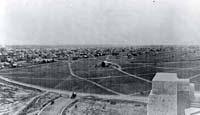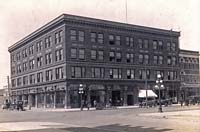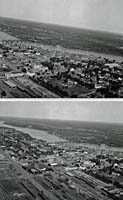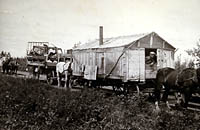4. The Forces of Push and Pull
 Here’s
an important question: were homesteaders really on the farm by choice? That
is hard to say. For many, it was an opportunity to leave a homeland where there was
little room for advancement. Sometimes they were escaping bad political situations. The
homestead, in some cases, was a quick stepping stone to other things, such as working for
the railroad, employment in a bank or a store, or opening a blacksmith shop. The
land policy based on immigration, homesteading and railways created what some have called,
an “artificial bubble” that has figured strongly into our past. The
bubble could not last.
Here’s
an important question: were homesteaders really on the farm by choice? That
is hard to say. For many, it was an opportunity to leave a homeland where there was
little room for advancement. Sometimes they were escaping bad political situations. The
homestead, in some cases, was a quick stepping stone to other things, such as working for
the railroad, employment in a bank or a store, or opening a blacksmith shop. The
land policy based on immigration, homesteading and railways created what some have called,
an “artificial bubble” that has figured strongly into our past. The
bubble could not last.
Push and pull factors entered with the sound of big gasoline tractors and farm machinery that needed lots of land for efficient use. Drawing on the American experience where the land was settled earlier, technology was adopted in western Canada quickly. It was inevitable that farms would have to grow in size in order to make machinery purchases worth it.
 The
quarter section was good for sustaining the original farm family, but could 6 sons and
daughters live on that quarter? They had to look for other livelihoods.
The
quarter section was good for sustaining the original farm family, but could 6 sons and
daughters live on that quarter? They had to look for other livelihoods.
The drought of
the 1930s pushed young people off the land, to ride the rails looking for work in eastern
cities. In the meantime, farmers in the south moved north to
settle homestead lands north of Prince Albert and the Tisdale area.
World War I and World War II drew young people to urban centres to work in war-related industries. Educational opportunities, such as teacher training, meant a move to urban centres, at least temporarily.
Population charts
| Year | Total Farms | Number of Farms Per Size Class | |||||
|---|---|---|---|---|---|---|---|
| One Quarter | Two Quarters | Three Quarters | 4 and 5 Quarters | 6 and 7 Quarters | Over 7 Quarters | ||
| 1936 | 142,391 | 49,880 | 47,793 | 18,691 | 18,039 | 4,751 | 3,237 |
| 1951 | 112,018 | 20,988 | 36,522 | 19,932 | 21,403 | 7,428 | 5,745 |
| Change | -28,892 | -11,271 | 1,241 | 3,364 | 2,677 | 2,508 | |
Source: Census of Canada and Census of the Prairie Provinces, Dominion Bureau of Statistics.
| Reasons for Moving to Town | Total Number of Responses* | Per Cent of Total Responses |
|---|---|---|
| School problems: school too far away, transportation too difficult or unreliable, school closed. | 46 | 30 |
| Ill health: must be near care, sick parents, children. | 22 | 14 |
| Roads blocked in winter, poor roads. | 25 | 16 |
| No conveniences on farm, no power or water, hard life on the farm. | 18 | 12 |
| Poor farm housing, poor repair, overcrowded, house burned. | 14 | 9 |
| Forced off farm, rental expired, went broke on farm. | 4 | 3 |
| Son married, living on farm, gradually taking over. | 4 | 3 |
| Job in town, have business in town besides running farm. | 7 | 5 |
| Isolation: neighbours gone, lonely in country. | 8 | 5 |
| No stock, no reason to stay on farm during winter months. | 5 | 3 |
| Total | 153 | 100 |
Source: Town farmer interview, Royal Commission on Agriculture and Rural Life, 1953.
* Responses add to more than 80 since a given individual might indicate several reasons
for moving.



